MIDDLE EAST: Yellow Rust Epidemic Affects Regional Wheat Crops
Agricultural scientists at the Borlaug Global Rust Initiative (BGRI) and the International Center for Agricultural Research for the Dry Areas (ICARDA) have reported that a major outbreak of a virulent new strain of yellow (stripe) rust has been identified in prime Middle Eastern wheat growing regions. The outbreak has reached epidemic proportions in Syria’s major grain producing provinces bordering Turkey and Iraq, with significant national crop losses expected. Outbreaks have also been reported in central and southeastern Turkey, northern Iraq, north, west and southern Iran, and in Lebanon. Outside the Middle East, yellow rust outbreaks have also been identified in Morocco, Azerbaijan, and Uzbekistan this year.
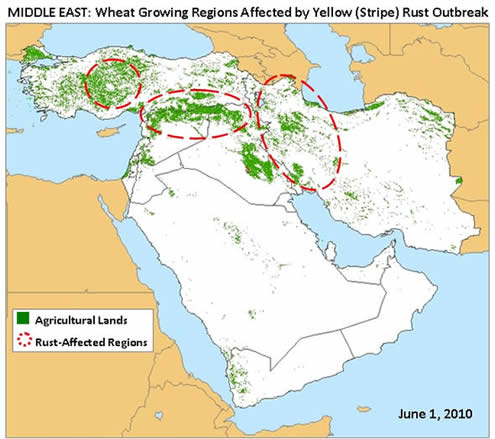
The current outbreak is primarily affecting soft bread wheat varieties, which form the backbone of the regions wheat crop. Hard wheat’s such as Durum are also grown in the region, but these varieties are a minority of total acreage. Scientists report that the new strain of yellow rust has plagued soft wheat crops that were previously resistant to the fungus owing to the incorporation of the gene Yr27. This implies that the majority of soft wheat grown in the region is under threat until newer resistant varieties are developed. The last major outbreak of yellow rust in the region was reported in the late 1980’s, resulting in a 21 percent reduction in regional wheat production.
Prior to the announcement of the current rust epidemic, wheat production in the Middle East was expected to rebound from several years of drought to a level of 41.1 million tons (an increase of 12 percent). The generally favorable environmental conditions which prevailed during the current winter growing season which would normally create bumper crop production potential, including above normal rainfall, mild winter temperatures, and lush crop growth, also apparently contributed to enhancing the spread of yellow rust and the severity of infection this season. Ideal meteorological conditions encouraged rapid development of yellow rust infections, massive spore production, and a lengthy period of time to infect regional crops.
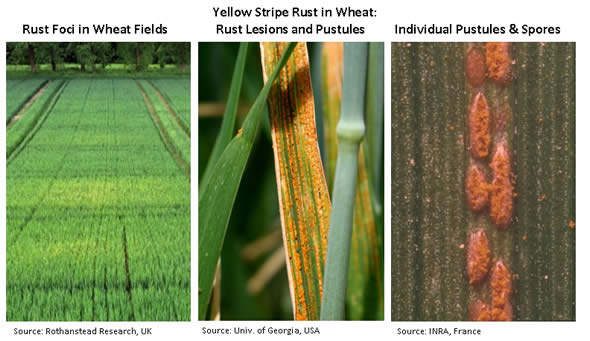
SYRIA:
In Syria, USDA has learned that record crop prospects have been dashed by severe infections of rust over broad regions. Crop development was especially lush this season, and repeated winter showers coupled with warmer than normal temperatures catalyzed a massive outbreak stretching from its borders with Lebanon in the west to the Iraq border in the east. Unfortunately, Syrian farmers reportedly did not spray preventative fungicides during the developing rust outbreak, and the epidemic was not able to be contained. Yellow rust generally afflicts the leaves of the wheat plant, consuming the stored nutrients and leaving them with a striped yellow or brown appearance. The fact that the plant leaves themselves are damaged or consumed during the lifecycle of the rust infection causes reductions in crop yields, as fewer stored nutrients are available to be transported to developing grains in the wheat head. The wheat head and its spikelet’s (where grain formation occurs) can also be infected, resulting in very serious yield losses In badly affected wheat fields, yield losses of 35-50 percent can occur, while in the worst instances nearly total crop loss is possible. Although the current yellow rust epidemic has been reported to predominantly affect soft wheat varieties, regional crop scientists in Iraq, Syria, and Turkey indicate that spikelet infection has been observed in some hard wheat crops as well.
The Syrian government has preliminarily reported that 2010/11 wheat production may fall as low as 3.3 million tons, an 18 percent reduction from last year and 35 percent below record levels thought possible a month ago. Harvest activities are ongoing across the country, and are some 30-40 days earlier than normal. Crop scientists at ICARDA indicate that early infections occurred in wheat crops during February and March, coinciding with vegetative and reproductive growth stages. Government estimates in late April indicate that rust-infected wheat acreage totaled 442,000 hectares, of which 300,000 hectares were un-harvestable (total loss). The un-harvested acreage estimate equates to 19 percent of total planted wheat area in Syria this year. Owing to the latest field information from crop scientists in the country, and acknowledging that it is still early in the harvest, USDA currently estimates 2010/11 Syrian wheat production at 3.75 million tons, down 1.25 million or 25 percent from last month. Wheat crops not seriously infected with rust are still expected to produce higher yields than last year, given the ideal moisture conditions experienced during the winter.
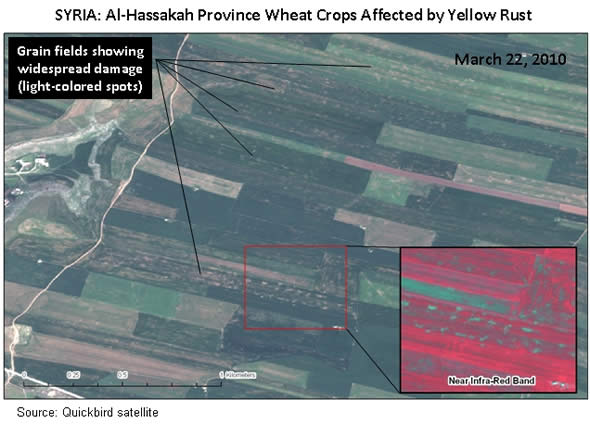
TURKEY:
Of equal concern is the fate of wheat crops in both Turkey and Iran. The Borlaug Global Rust Initiative (BGRI) has reported that yellow rust outbreaks have occurred in the Middle East’s two major wheat producers, who collectively account for 80 percent of total regional wheat production. Crop stage in these two countries are less advanced than in Syria, and have had similarly favorable environmental conditions for rust incubation and development. The severity of the epidemic in northern Syria ensured massive spore production occurred, with unknown consequences to adjoining wheat lands in Turkey. Local and regional officials in Turkey have reported yellow rust outbreaks in the prime Central Anatolian and southeastern wheat growing regions. The epidemic appears most concentrated, however, in Turkey’s southern and southeastern provinces where up to 20-25 percent of the national wheat crop is grown. Farmers have reported that the rust epidemic is widespread in these southern regions, and is affecting both soft and hard wheat crops. Wheat harvest activities are just beginning in southeastern Turkey and will continue into August in the later-maturing highland growing regions. Farmers have not reported the degree of yield loss in the hard-hit areas being harvested, so it is as yet uncertain what level of yield reduction has occurred. At this early stage USDA estimates 2010/11 wheat production in Turkey at 17.5 million tons, down 1.0 million or 5 percent from last month. Continued monitoring of crop yields and harvest progress will be needed to more accurately gauge the actual impact on national wheat production.
IRAN:
In Iran, outbreaks have been identified by BGRI and ICARDA scientists in north, western and southern provinces. The BGRI indicated that farmers in Iran had observed the outbreaks and had sprayed fungicides in order to attempt to control the spread of the infection. News updates, however, have not yet been posted to inform the public on the effectiveness of their efforts. USDA’s Middle East remote sensing program has been monitoring the region this winter and is currently seeing much less evidence of potential crop damage inside Iran when compared with its neighbors. One of the key observable signals of severely infected wheat crops is premature senescence or maturation of the crop. Prolonged exposure to the rust pathogen causes severe damage to the green leaf biomass, causing it to turn necrotic (yellow or brown). This premature loss of green vegetative crop biomass can be identified by satellites which measure the growth and development of the crop via normalized vegetation index’s or NDVI. The NDVI signal in virtually all severely infected regions this year indicates crops are entering maturation growth phases 4-6 weeks earlier than normal. In Iran, the nation’s wheat growing areas are widely dispersed in a very mountainous environment. Many areas may have been sheltered to some degree from exposure to rust spores generated in Syria and Turkey. Whatever the reason, satellite image analysis indicates Iran’s wheat crop is generally maturing on a normal schedule, with the exception of a few growing areas in the west and south which are maturing 2-4 weeks early. USDA is currently estimating Iran’s 2010/11 wheat production unchanged at 14.4 million tons.
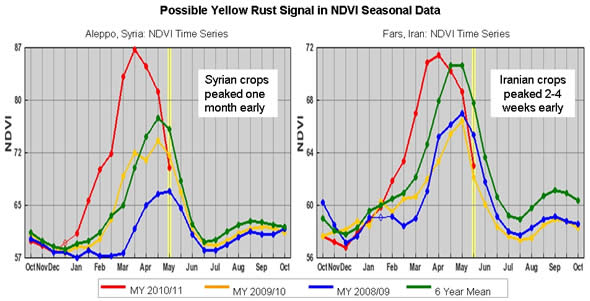
IRAQ:
BGRI, ICARDA, and Iraqi field scientists have also confirmed yellow rust outbreaks in at least four northern Iraqi provinces, namely Ninawa, At-Tamin (Kirkuk), Arbil, and Salah ad Din. These four provinces normally account for 40 percent of the national wheat crop. Ninawa sits astride the northeastern Syrian border, and is the home of Iraq’s breadbasket, producing approximately 20 percent of the national wheat crop on its own. The most serious and concentrated rust infections in Syria were reported to have occurred in the northeastern province of Al-Hassakah, which shares a border with Ninawa. Wheat crops in western, central and northern Ninawa are believed to be seriously infected. Northern Iraq, like Syria, had an extremely favorable winter rainfall pattern this year which contributed to record-level crop vegetative development. Lush wheat fields grew over large areas in the rust-affected provinces which had largely lain barren the past two years during a prolonged and severe drought. Much of the projected rebound in Iraq’s national wheat production outlook this year stemmed from the increased crop acreage and improved growing conditions in northern growing areas. The proximity of northern Iraq’s wheat lands to the rust epidemic in Syria, and the prevailing westerly wind direction, ensured it had a high probability of becoming infected. As of early June field scientists were not overly concerned with the degree of damage they were observing, indicating that crops in affected areas might suffer 10-15 percent yield declines. USDA currently estimates 2010/11 Iraq wheat production unchanged at 2.0 million tons. Provincial yield estimates, however, were much changed, with Ninawa, Arbil, and At Tamin being estimated lower, while crop yields in Dahuk and As Sulaymaniyah were increased. The regional wheat yield adjustments essentially canceled each other out. Foreign Agricultural Service reports concerning the harvest are expected in the next several months, and they will further reveal the extent of damage from this serious fungal epidemic.
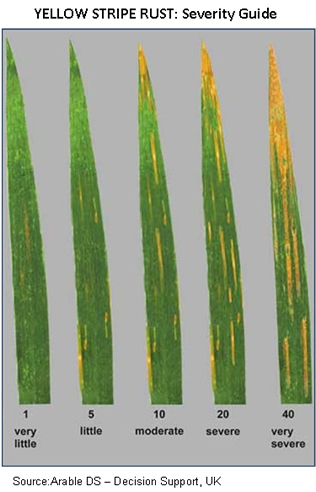
Current USDA area and production estimates for grains and other agricultural commodities are available on IPAD's Agricultural Production page or at PSD Online.
|

